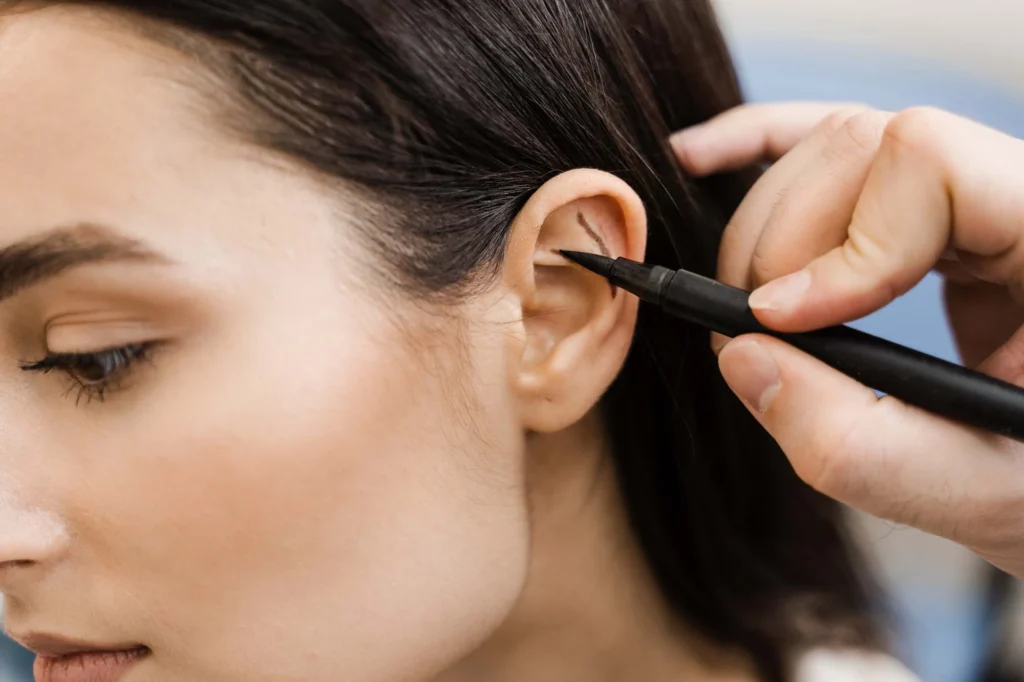Otoplasty 101: A Comprehensive Guide to Prominent Ear Correction Surgery
Prominent ears, a common aesthetic concern, can significantly impact an individual’s self-confidence, particularly during childhood and adolescence. Fortunately, modern surgical techniques, collectively known as Otoplasty, offer a permanent and effective solution to this issue. But what exactly is Otoplasty surgery, who is a suitable candidate, and what does the recovery process entail?
With expertise in ENT and aesthetic surgery, this comprehensive guide will answer all your questions about ear correction surgery, from A to Z.
What is Prominent Ear (Otoplasty) and How is it Performed?
Otoplasty, also widely known as ear pinning surgery or ear reshaping surgery, is a surgical procedure designed to correct the shape and position of ears that protrude excessively from the head. The goal is to achieve a more natural, balanced appearance that harmonizes with the facial features.
This condition typically stems from two primary anatomical reasons, which the surgery aims to address:
- Underdeveloped Antihelical Fold: The natural fold along the rim of the ear (the antihelical fold) may be poorly formed or absent. This lack of a distinct fold causes the ear to appear flat and to stick out.
- Overdeveloped Conchal Cartilage: The large, bowl-shaped part of the outer ear (the concha) may be excessively large or deep, pushing the entire ear further away from the side of the head.
The Surgical Process: Step-by-Step Otoplasty
Otoplasty is generally an outpatient procedure, meaning patients can usually return home the same day. The surgery typically lasts between 1 to 2 hours. The key stages involved are:
- Anesthesia: Depending on the patient’s age and overall health, either general anesthesia (more common for children) or local anesthesia with sedation (often preferred for adults) can be used to ensure comfort during the procedure.
- Incision: The incision is strategically placed on the back surface of the ear, hidden within the natural crease where the ear meets the head. This placement ensures that any resulting otoplasty scars are virtually invisible once healed.
- Cartilage Reshaping and Repositioning: The surgeon carefully accesses and reshapes the ear cartilage. This usually involves one or both of the following techniques:
- Creating the Antihelical Fold: Techniques like the Mustardé procedure use permanent sutures to create or enhance the missing antihelical fold, giving the ear a more natural curve.
- Reducing Conchal Prominence: Techniques such as the Furnas procedure use permanent sutures to set back the overly prominent conchal cartilage, drawing the ear closer to the head.
- Closure: The incision is meticulously closed with fine sutures (often dissolvable), and a protective dressing or head bandage is applied to maintain the new ear shape and minimize swelling.

Who is a Suitable Candidate for Prominent Ear Correction Surgery?
Otoplasty can provide significant aesthetic and psychological benefits for a wide range of individuals.
| Criterion | Description |
| Ideal Age Range | Children aged 5-6 years and older. By this age, ear cartilage is sufficiently developed, and undergoing surgery can prevent potential psychological distress (e.g., bullying) in school environments. |
| Adults | Any adult over 18 years of age with good general health and realistic expectations can undergo Otoplasty to enhance their self-esteem. Local anesthesia is frequently used for adult procedures. |
| Psychological Readiness | For pediatric patients, the decision for ear correction surgery should ideally come from the child’s own desire, not solely parental pressure. Adults should have clear and realistic expectations about the surgical outcome. |
Non-Surgical and Minimally Invasive Alternatives: Suture Otoplasty and Infant Ear Molding
While traditional surgical Otoplasty offers the most definitive and lasting solution, some less invasive alternatives may be suitable for specific cases.
1. Suture Otoplasty (Minimally Invasive Ear Pinning)
In recent years, suture otoplasty has gained popularity. This technique aims to reshape the ear cartilage using permanent sutures without making large surgical incisions.
- Advantages: Shorter recovery time, typically performed under local anesthesia, and no visible external scars.
- Limitations: This method is best suited for patients with softer cartilage and primarily an underdeveloped antihelical fold. For cases with overly large or stiff cartilage, traditional prominent ear surgery often provides more robust and long-lasting results.
2. Infant Ear Molding (Non-Surgical Ear Correction for Babies)
In the first few weeks after birth, a baby’s ear cartilage is exceptionally soft and pliable. During this critical window, specialized ear molds or splints can be used to reshape the ear and correct conditions like prominent ears without surgery. This represents the most successful period for non-surgical ear correction in infants.
Otoplasty Recovery Timeline and Post-Operative Care Tips
The Otoplasty recovery period is crucial for the success of the procedure and the permanence of the newly achieved ear shape.
| Period | Expectations and Care Instructions |
| First 1-7 Days | Bandage Care: A protective head dressing applied immediately after surgery must be worn continuously for 3-7 days to reduce swelling and protect the ears from trauma. Pain Management: Mild pain and discomfort are normal and can be easily managed with prescribed pain medication. |
| First 2-6 Weeks | Headband Use: After the initial dressing is removed, you will be advised to wear an elastic headband for a specified period (typically 4-6 weeks), especially at night. This helps the cartilage conform to its new position and protects the ears. Activity: Most patients can return to work or school after one week. Strenuous exercise and contact sports with a risk of head trauma should be avoided for at least 6 weeks. |
| Scar Management | Incision scars are well-hidden behind the ear and usually fade over time, becoming almost imperceptible. Follow your surgeon’s recommendations for otoplasty scar care. |
| Permanent Results | Full resolution of swelling and the final ear shape may take several months to fully manifest. The results of Otoplasty are generally permanent, providing lifelong satisfaction for the vast majority of patients. The rare risk of otoplasty regression (ears sticking out again) is minimized with proper surgical technique and diligent post-operative care. |
Why Choose for Your Otoplasty?
Ear aesthetic surgery, while appearing straightforward, demands meticulous surgical precision, extensive aesthetic experience, and a deep understanding of cartilage anatomy to achieve natural-looking results that complement facial symmetry.
As a specialist in ENT and Aesthetic Surgery, our approach to Otoplasty involves:
- Functional and Aesthetic Harmony: We ensure that the ear’s healthy function is preserved alongside its aesthetic enhancement.
- Personalized Treatment Plans: Each patient’s ear anatomy is thoroughly analyzed (e.g., underdeveloped antihelical fold vs. conchal hypertrophy) to determine the most appropriate surgical or minimally invasive technique.
- Natural-Looking Outcomes: The goal is not merely to “pin back” the ears but to sculpt ears with natural contours that blend seamlessly with your overall facial features.
To learn more about Otoplasty, inquire about ear surgery cost, and develop a personalized treatment plan tailored to your needs, contact us today for an appointment. Begin your journey to renewed self-confidence!

